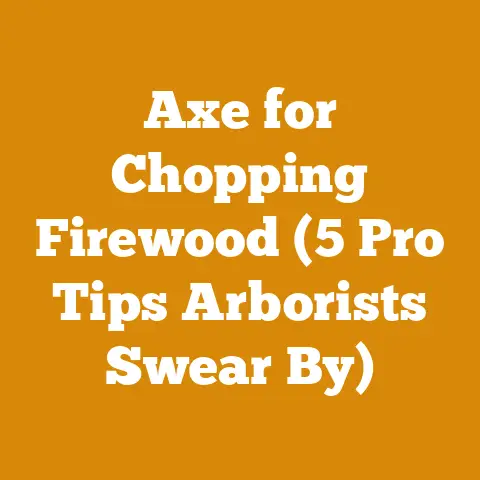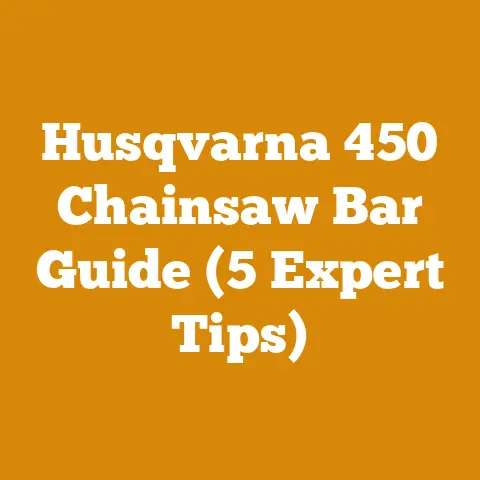Weed Eater Saw Blades for Heavy Brush (Pro Arborist Insights)
Ever wrestled with thick brush so stubborn it laughs at your string trimmer? I have, more times than I care to admit. That’s when I discovered the game-changing potential of weed eater saw blades. As a seasoned arborist, I’ve put countless tools to the test, and these blades have earned their place in my arsenal, especially for tackling heavy brush. This guide dives deep into the world of weed eater saw blades, offering pro insights to help you choose the right one and use it safely and effectively.
Understanding Weed Eater Saw Blades: A Pro Arborist’s Perspective
Weed eater saw blades aren’t your typical trimming line. They’re designed for tougher stuff – thick weeds, small saplings, and dense brush that would shred a trimmer line in seconds. I’ve found them invaluable for clearing overgrown areas, creating firebreaks, and maintaining property lines.
What are Weed Eater Saw Blades?
These blades are circular or multi-pointed metal attachments that replace the standard string head on a weed eater (also known as a string trimmer or brush cutter). They come in various sizes, shapes, and materials, each suited for different types of vegetation. I’ve personally used blades ranging from 8 inches to 12 inches in diameter, depending on the density of the brush I was tackling.
Why Choose a Saw Blade Over Trimmer Line?
The primary advantage is cutting power. Trimmer line relies on high-speed whipping action, which is effective for grass and light weeds. Saw blades, on the other hand, use sharp teeth to slice through thicker vegetation. I remember one particularly challenging job clearing a patch of blackberry bushes that had completely taken over a section of a client’s yard. Trimmer line was useless, but a saw blade made quick work of the task.
Types of Weed Eater Saw Blades
Understanding the different types of blades is crucial for selecting the right tool for the job. Here’s a breakdown of the most common types I’ve encountered:
- Circular Saw Blades: These are solid steel discs with teeth around the perimeter, similar to miniature circular saw blades. They’re excellent for cutting through small trees and thick brush.
- Brush Cutter Blades (Multi-Tooth Blades): These blades have multiple teeth or cutting edges arranged around a central hub. They’re versatile and suitable for a wide range of vegetation. I often use these for general brush clearing.
- Chisel Tooth Blades: These blades feature teeth that are angled like chisels, providing aggressive cutting action. They’re ideal for tougher, woodier vegetation.
- Tri-Blades (3-Tooth Blades): These blades have three sharp blades extending from a central hub. They’re known for their durability and ability to cut through thick vegetation quickly. I’ve used these in situations where I needed to clear large areas rapidly.
- String Trimmer Blades (Plastic or Composite): While not technically “saw blades,” these rigid plastic or composite blades offer more cutting power than standard string. They’re a good option for light to medium brush.
Material Matters: Blade Construction
The material of the blade significantly impacts its durability and performance. I’ve found that high-quality steel blades last longer and maintain their sharpness better than cheaper alternatives.
- Steel: The most common material, offering a good balance of strength and affordability. Look for high-carbon steel for increased durability.
- High-Speed Steel (HSS): HSS blades are harder and more resistant to wear than standard steel blades. They’re a good choice for demanding applications.
- Carbide-Tipped: These blades have carbide inserts brazed onto the teeth, providing exceptional hardness and wear resistance. Carbide-tipped blades are the most expensive option but offer the longest lifespan.
Choosing the Right Blade: A Step-by-Step Guide
Selecting the right blade is crucial for safety and efficiency. I always consider the type of vegetation I’ll be cutting, the power of my weed eater, and the overall size of the area I need to clear.
Step 1: Assess Your Vegetation
The first step is to identify the type of vegetation you’ll be cutting.
- Light Brush: Grass, weeds, and small, soft-stemmed plants. A string trimmer blade or a multi-tooth blade will likely suffice.
- Medium Brush: Thicker weeds, small saplings (up to 1 inch in diameter), and dense foliage. A brush cutter blade or a circular saw blade is a good choice.
- Heavy Brush: Thick saplings (up to 3 inches in diameter), dense shrubs, and woody vegetation. A chisel tooth blade or a tri-blade is recommended.
Step 2: Consider Your Weed Eater’s Power
Your weed eater’s engine size and power output will determine the maximum blade size you can use effectively. Using a blade that’s too large for your weed eater can strain the engine and reduce cutting performance.
- Small Weed Eaters (under 25cc): Stick to smaller blades (8-9 inches) and avoid heavy-duty blades like chisel tooth or tri-blades.
- Medium Weed Eaters (25-35cc): You can use blades up to 10 inches in diameter, including brush cutter blades and circular saw blades.
- Large Weed Eaters (over 35cc): These can handle larger blades (up to 12 inches) and heavier-duty blades like chisel tooth and tri-blades.
I once tried to use a 12-inch chisel tooth blade on a small 25cc weed eater, and it was a disaster. The engine bogged down, and the blade barely made a dent in the brush. Lesson learned: match the blade to the machine.
Step 3: Match the Arbor Size
The arbor size is the diameter of the hole in the center of the blade that fits onto the weed eater’s spindle. Make sure the blade’s arbor size matches your weed eater’s spindle size. Adapters are available, but it’s best to use a blade with the correct arbor size for a secure fit. I always double-check the arbor size before purchasing a blade to avoid compatibility issues.
Step 4: Read Reviews and Seek Recommendations
Before buying a blade, read online reviews and ask for recommendations from other arborists or landscaping professionals. Real-world feedback can provide valuable insights into the blade’s performance and durability. I often consult with my colleagues before trying a new blade to get their opinions.
Blade Selection Chart
| Vegetation Type | Blade Type | Weed Eater Size | Arbor Size |
|---|---|---|---|
| Light Brush | String Trimmer Blade, Multi-Tooth | Small | Varies |
| Medium Brush | Brush Cutter, Circular Saw | Medium | Varies |
| Heavy Brush | Chisel Tooth, Tri-Blade | Large | Varies |
Safety First: Essential Precautions
Using weed eater saw blades can be dangerous if proper safety precautions are not followed. I always prioritize safety when working with these tools.
Personal Protective Equipment (PPE)
- Eye Protection: Wear safety glasses or a face shield to protect your eyes from flying debris. I’ve had close calls with flying rocks and wood chips, so I never work without eye protection.
- Hearing Protection: Weed eaters can be loud, especially when equipped with saw blades. Wear earplugs or earmuffs to protect your hearing.
- Gloves: Wear heavy-duty work gloves to protect your hands from cuts and abrasions.
- Long Pants and Sleeves: Wear long pants and sleeves to protect your skin from scratches and cuts.
- Steel-Toed Boots: Wear steel-toed boots to protect your feet from injury.
- Leg Protection: Consider wearing chaps or leg guards for added protection, especially when cutting thick brush.
Weed Eater Safety Features
- Blade Guard: Ensure your weed eater has a properly installed blade guard to deflect debris and prevent accidental contact with the blade.
- Harness or Shoulder Strap: Using a harness or shoulder strap can help distribute the weight of the weed eater and reduce fatigue. This is especially important when using larger blades for extended periods.
- Emergency Shut-Off Switch: Familiarize yourself with the location of the emergency shut-off switch so you can quickly stop the blade in case of an emergency.
Safe Operating Procedures
- Clear the Area: Before starting, clear the area of any obstacles, such as rocks, branches, and debris.
- Inspect the Blade: Inspect the blade for damage before each use. Replace any damaged or worn blades.
- Start the Weed Eater on a Flat Surface: Start the weed eater on a flat, stable surface.
- Maintain a Firm Grip: Maintain a firm grip on the weed eater with both hands.
- Use a Wide Stance: Use a wide stance for stability and balance.
- Keep the Blade Away from Your Body: Keep the blade away from your body and other people.
- Avoid Cutting Near Hard Objects: Avoid cutting near hard objects, such as rocks, fences, and buildings, as this can damage the blade and cause dangerous kickback.
- Be Aware of Your Surroundings: Be aware of your surroundings and watch out for hidden obstacles or hazards.
- Take Breaks: Take frequent breaks to avoid fatigue.
- Never Modify the Blade: Never modify the blade in any way, as this can compromise its safety and performance.
- Sharpen the Blade Regularly: Keep the blade sharp to ensure efficient cutting and reduce the risk of kickback.
- Store Blades Safely: When not in use, store blades in a safe place where they won’t be damaged or cause injury.
I once witnessed a colleague who neglected to wear eye protection while using a weed eater saw blade. A small rock was thrown up by the blade and struck him in the eye, causing a serious injury. This incident reinforced the importance of always wearing proper PPE.
Installing and Maintaining Your Blade
Proper installation and maintenance are essential for ensuring the safety and performance of your weed eater saw blade.
Installing the Blade
- Turn Off the Weed Eater: Always turn off the weed eater and disconnect the spark plug before installing or removing a blade.
- Remove the String Head: Remove the string head from the weed eater.
- Install the Adapter (If Necessary): If the blade requires an adapter, install it onto the weed eater’s spindle.
- Mount the Blade: Mount the blade onto the spindle, ensuring it’s facing the correct direction. The teeth should be pointing in the direction of rotation.
- Secure the Blade: Secure the blade with the retaining nut or bolt. Tighten it securely using a wrench.
- Check for Proper Rotation: Manually rotate the blade to ensure it spins freely and doesn’t wobble.
- Reinstall the Blade Guard: Reinstall the blade guard.
Sharpening the Blade
A sharp blade is essential for efficient cutting and reducing the risk of kickback. I recommend sharpening your blade regularly, depending on how often you use it and the type of vegetation you’re cutting.
- Visual Inspection: Inspect the blade for dullness or damage. If the teeth are rounded or chipped, it’s time to sharpen the blade.
- Use a File or Grinder: Use a file or grinder to sharpen the blade. Follow the original angle of the teeth.
- Wear Eye Protection: Always wear eye protection when sharpening a blade.
- Maintain Balance: Ensure the blade is balanced after sharpening. An unbalanced blade can cause vibration and reduce cutting performance.
Cleaning and Storage
After each use, clean the blade with a wire brush to remove any debris or sap. Store the blade in a dry place to prevent rust. I often coat my blades with a light oil to protect them from corrosion.
Advanced Techniques: Mastering the Art of Brush Clearing
Once you’re comfortable with the basics, you can start experimenting with advanced techniques to improve your brush clearing efficiency.
Felling Small Trees
Weed eater saw blades can be used to fell small trees up to 3 inches in diameter.
- Assess the Tree: Assess the tree for any hazards, such as dead branches or power lines.
- Clear the Area: Clear the area around the tree of any obstacles.
- Make a Notch: Make a notch on the side of the tree in the direction you want it to fall.
- Make a Back Cut: Make a back cut on the opposite side of the tree, slightly above the notch.
- Wedge the Tree (If Necessary): If the tree doesn’t start to fall on its own, use a wedge to help it along.
- Move Away from the Tree: As the tree falls, move away from it quickly.
Creating Firebreaks
Firebreaks are essential for preventing wildfires from spreading. Weed eater saw blades can be used to create firebreaks by clearing vegetation down to bare soil.
- Identify the Firebreak Location: Identify the location of the firebreak.
- Clear Vegetation: Clear all vegetation within the firebreak area.
- Remove Debris: Remove all debris, such as leaves, branches, and logs.
- Create a Bare Soil Strip: Create a strip of bare soil at least 6 feet wide.
Clearing Overgrown Areas
Weed eater saw blades are ideal for clearing overgrown areas that are too difficult to manage with a lawnmower or string trimmer.
- Assess the Area: Assess the area for any hazards, such as rocks, holes, or hidden objects.
- Start at the Edge: Start at the edge of the overgrown area and work your way inward.
- Use a Swinging Motion: Use a swinging motion to cut through the vegetation.
- Overlap Your Cuts: Overlap your cuts to ensure complete coverage.
- Remove Debris: Remove debris as you go to prevent it from getting tangled in the blade.
Pro Tips for Efficient Brush Clearing
- Work in Sections: Divide the area into smaller sections to make the task more manageable.
- Use a System: Develop a system for clearing the vegetation to ensure you don’t miss any spots.
- Take Breaks: Take frequent breaks to avoid fatigue.
- Stay Hydrated: Drink plenty of water to stay hydrated, especially in hot weather.
- Dress Appropriately: Dress appropriately for the weather conditions.
- Communicate with Others: If you’re working with others, communicate clearly to avoid accidents.
I once had to clear a heavily overgrown area that was infested with poison ivy. I wore a full-body protective suit and used a weed eater saw blade to cut through the vegetation. It was a challenging job, but the saw blade made it much easier.
Troubleshooting Common Issues
Even with proper technique and maintenance, you may encounter some common issues when using weed eater saw blades.
Blade Binding
Blade binding occurs when the blade gets stuck in the vegetation. This can be caused by several factors, such as:
- Dull Blade: A dull blade is more likely to bind than a sharp blade.
- Thick Vegetation: Cutting through thick vegetation can cause the blade to bind.
- Wet Vegetation: Wet vegetation can be more difficult to cut and can cause the blade to bind.
- Incorrect Blade Angle: Cutting at an incorrect angle can cause the blade to bind.
To resolve blade binding:
- Stop the Weed Eater: Stop the weed eater immediately.
- Remove the Blade: Carefully remove the blade from the vegetation.
- Sharpen the Blade: Sharpen the blade if it’s dull.
- Adjust Your Angle: Adjust your cutting angle.
- Reduce Speed: Reduce your cutting speed.
Kickback
Kickback occurs when the blade suddenly bounces back towards you. This can be caused by several factors, such as:
- Hitting a Hard Object: Hitting a rock, fence, or other hard object can cause kickback.
- Pinching the Blade: Pinching the blade between two pieces of wood can cause kickback.
- Cutting at an Incorrect Angle: Cutting at an incorrect angle can cause kickback.
To prevent kickback:
- Avoid Hard Objects: Avoid cutting near hard objects.
- Maintain a Firm Grip: Maintain a firm grip on the weed eater.
- Use a Wide Stance: Use a wide stance for stability and balance.
- Cut at the Correct Angle: Cut at the correct angle.
- Sharpen the Blade Regularly: Keep the blade sharp to reduce the risk of kickback.
Vibration
Excessive vibration can be uncomfortable and can cause fatigue. It can be caused by several factors, such as:
- Unbalanced Blade: An unbalanced blade can cause vibration.
- Loose Blade: A loose blade can cause vibration.
- Worn Bearings: Worn bearings in the weed eater’s engine can cause vibration.
To reduce vibration:
- Balance the Blade: Balance the blade after sharpening.
- Tighten the Blade: Tighten the blade securely.
- Check the Bearings: Have the bearings in the weed eater’s engine checked by a qualified mechanic.
Engine Problems
Using a weed eater saw blade can put extra strain on the engine. This can lead to engine problems, such as:
- Overheating: The engine can overheat if it’s working too hard.
- Stalling: The engine can stall if it’s not getting enough fuel or air.
- Reduced Power: The engine can lose power if it’s not running efficiently.
To prevent engine problems:
- Use the Correct Blade Size: Use a blade that’s appropriate for your weed eater’s engine size.
- Don’t Overload the Engine: Don’t try to cut through vegetation that’s too thick for the blade.
- Clean the Air Filter: Clean the air filter regularly.
- Use Fresh Fuel: Use fresh fuel.
- Maintain the Spark Plug: Maintain the spark plug.
- Have the Engine Serviced Regularly: Have the engine serviced regularly by a qualified mechanic.
I once had an engine overheat while using a weed eater saw blade on a hot day. I stopped the engine, let it cool down, and cleaned the air filter. After that, the engine ran fine.
Weed Eater Saw Blades: Environmental Considerations
As arborists, we have a responsibility to minimize our impact on the environment. When using weed eater saw blades, consider the following:
Noise Pollution
Weed eaters can be noisy, especially when equipped with saw blades. Be mindful of noise pollution and avoid using them during early morning or late evening hours, especially in residential areas. I always try to be considerate of my neighbors when using power equipment.
Air Pollution
Weed eaters powered by gasoline engines emit exhaust fumes that contribute to air pollution. Consider using electric-powered weed eaters to reduce emissions.
Soil Erosion
Clearing vegetation with weed eater saw blades can expose the soil to erosion. Take steps to prevent soil erosion, such as:
- Leaving Root Systems Intact: Leave the root systems of plants intact to help stabilize the soil.
- Mulching: Mulch the cleared area to protect the soil from erosion.
- Planting Ground Cover: Plant ground cover to help stabilize the soil.
Wildlife Habitat
Clearing vegetation can disrupt wildlife habitat. Avoid clearing vegetation during nesting season and leave some areas of undisturbed vegetation to provide shelter for wildlife.
Disposal of Debris
Dispose of debris properly. Compost organic debris, such as leaves and branches. Recycle metal blades and other materials whenever possible.
The Future of Weed Eater Saw Blades
The technology behind weed eater saw blades is constantly evolving. Here are some trends to watch for:
Improved Blade Materials
Manufacturers are developing new blade materials that are stronger, more durable, and more resistant to wear. This will lead to blades that last longer and perform better.
Enhanced Blade Designs
New blade designs are being developed to improve cutting efficiency and reduce kickback. These designs incorporate features such as:
- Curved Teeth: Curved teeth provide a more aggressive cutting action.
- Anti-Kickback Features: Anti-kickback features help to prevent the blade from bouncing back towards the operator.
- Vibration Dampening: Vibration dampening features reduce vibration and improve operator comfort.
Smart Blades
Smart blades are being developed that incorporate sensors and electronics to monitor blade performance and provide feedback to the operator. These blades can:
- Detect Blade Dullness: Detect when the blade is dull and needs to be sharpened.
- Measure Cutting Speed: Measure the cutting speed and provide feedback to the operator to optimize performance.
- Prevent Overloading: Prevent the engine from being overloaded.
Electric Weed Eaters
Electric weed eaters are becoming more powerful and efficient. They offer several advantages over gasoline-powered weed eaters, such as:
- Reduced Emissions: Electric weed eaters produce zero emissions.
- Quieter Operation: Electric weed eaters are quieter than gasoline-powered weed eaters.
- Lower Maintenance: Electric weed eaters require less maintenance than gasoline-powered weed eaters.
As electric weed eaters become more prevalent, we can expect to see more advanced saw blade designs specifically tailored for these machines.
Real-World Case Studies
To illustrate the effectiveness of weed eater saw blades, let’s look at some real-world case studies.
Case Study 1: Clearing a Heavily Overgrown Property Line
A homeowner had a property line that was heavily overgrown with blackberry bushes, poison ivy, and small saplings. The homeowner had tried to clear the property line with a string trimmer, but it was ineffective. I used a weed eater equipped with a 10-inch brush cutter blade to clear the property line. The blade easily cut through the thick vegetation, and I was able to clear the entire property line in just a few hours.
Case Study 2: Creating a Firebreak in a Rural Area
A rural homeowner wanted to create a firebreak around their property to protect it from wildfires. I used a weed eater equipped with a 12-inch chisel tooth blade to clear a strip of vegetation down to bare soil. The blade was able to cut through thick brush and small trees, creating an effective firebreak.
Case Study 3: Removing Invasive Species from a Forest
A forest management company wanted to remove invasive species, such as buckthorn and honeysuckle, from a forest. I used a weed eater equipped with a tri-blade to cut down the invasive species. The blade was able to quickly and efficiently remove the invasive species, allowing native plants to thrive.
Final Thoughts: Embracing the Power of Weed Eater Saw Blades
Weed eater saw blades are powerful tools that can make brush clearing and other landscaping tasks much easier. However, it’s important to choose the right blade for the job and to use it safely. By following the tips and precautions outlined in this guide, you can harness the power of weed eater saw blades to tackle even the toughest vegetation challenges. Remember, safety always comes first. Take your time, wear the appropriate PPE, and always be aware of your surroundings. With the right blade and a little practice, you’ll be able to clear brush like a pro.






